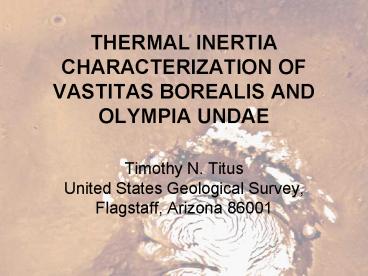THERMAL INERTIA CHARACTERIZATION OF VASTITAS BOREALIS AND OLYMPIA UNDAE
1 / 16
Title:
THERMAL INERTIA CHARACTERIZATION OF VASTITAS BOREALIS AND OLYMPIA UNDAE
Description:
Successfully used KRC Thermal Model combined with TES observations to detect ... TES Albedo & Thermal Bolometer Observations. Restricted to Late-Spring & Summer ... –
Number of Views:89
Avg rating:3.0/5.0
Title: THERMAL INERTIA CHARACTERIZATION OF VASTITAS BOREALIS AND OLYMPIA UNDAE
1
THERMAL INERTIA CHARACTERIZATION OF VASTITAS
BOREALIS ANDOLYMPIA UNDAE
- Timothy N. Titus
- United States Geological Survey, Flagstaff,
Arizona 86001
2
Motivation Background
- GRS Suite of Instruments
- High Concentrations of WEH measurements in polar
regions. - WEH minimum in Eastern Olympia Undae.
- TES KRC
- Successfully used KRC Thermal Model combined with
TES observations to detect water ice at edge of
the SPRC
3
The Thermal Model
- TES Albedo Thermal Bolometer Observations
- Restricted to Late-Spring Summer
- KRC Two-Layer Model
- Surface Layer Thermal Inertia
- Surface Layer Depth
- Bottom Layer Thermal Inertia
- Model Fits
- Time-dependent Albedo
- Constant Dust Opacity of 0.2
Depth
Thermal Inertia
Thermal Inertia
4
Top Layer Thermal Inertia
5
Lower Layer Thermal Inertia
6
Top Layer Depth (mm)
7
Cross-SectionLatitude 80.5N
- 5-10 cm of sand on top of ice
8
Cross-SectionLatitude 80.5N
- 5-10 cm of sand on top of ice
9
Cross-SectionLongitude 179 E
- Ice Table Edge is 66N
10
Cross-SectionLongitude 179 E
- Ice Table Edge is 66N
11
Cross-SectionLongitude 189 E
- Ice Table Edge is 67N
12
Cross-SectionLongitude 189 E
- Ice Table Edge is 67N
13
Cross-SectionLongitude 221 E
- Ice Table Edge is south of 65N
14
Cross-SectionLongitude 221 E
- Ice Table Edge is south of 65N
15
Results
- Olympia Undae is frozen with 5-10 cm overburden
of sand. (Consistent with papers by Mary Bourke
and Bill Feldman et al.) - The thermal edge of the ice table is consistent
with that derived from neutrons. - Low hydrogen detection in Olympia Undae
corresponds to a deeper ice table. - The ice table may have a thermal inertia higher
than that expected for either bedrock or pure
ice. - Could be an effect from non-atmospherically
corrected albedo - Possible Implications for formation mechanisms
16
Future Work
- New MDAP Funding
- 60km resolution
- Both Polar Regions
- Variable Opacity
- Atmospherically-corrected albedo
- Combine with Mars Odyssey Neutron Spectrometer
observations































